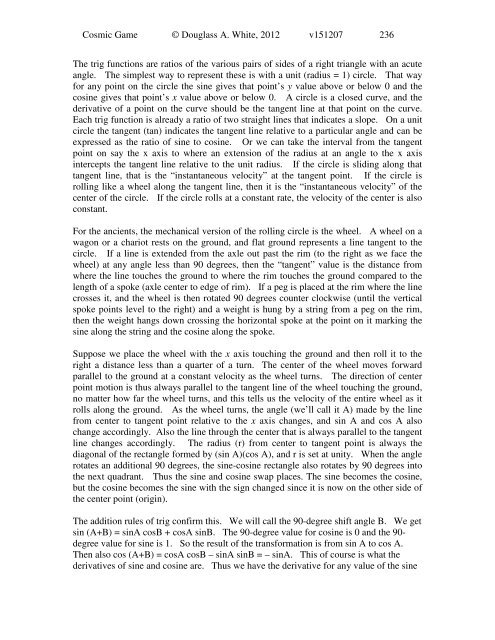You also want an ePaper? Increase the reach of your titles
YUMPU automatically turns print PDFs into web optimized ePapers that Google loves.
<strong>Cosmic</strong> <strong>Game</strong> © Douglass A. White, 2012 v151207 236<br />
<strong>The</strong> trig functions are ratios of the various pairs of sides of a right triangle with an acute<br />
angle. <strong>The</strong> simplest way to represent these is with a unit (radius = 1) circle. That way<br />
for any point on the circle the sine gives that point’s y value above or below 0 and the<br />
cosine gives that point’s x value above or below 0. A circle is a closed curve, and the<br />
derivative of a point on the curve should be the tangent line at that point on the curve.<br />
Each trig function is already a ratio of two straight lines that indicates a slope. On a unit<br />
circle the tangent (tan) indicates the tangent line relative to a particular angle and can be<br />
expressed as the ratio of sine to cosine. Or we can take the interval from the tangent<br />
point on say the x axis to where an extension of the radius at an angle to the x axis<br />
intercepts the tangent line relative to the unit radius. If the circle is sliding along that<br />
tangent line, that is the “instantaneous velocity” at the tangent point. If the circle is<br />
rolling like a wheel along the tangent line, then it is the “instantaneous velocity” of the<br />
center of the circle. If the circle rolls at a constant rate, the velocity of the center is also<br />
constant.<br />
For the ancients, the mechanical version of the rolling circle is the wheel. A wheel on a<br />
wagon or a chariot rests on the ground, and flat ground represents a line tangent to the<br />
circle. If a line is extended from the axle out past the rim (to the right as we face the<br />
wheel) at any angle less than 90 degrees, then the “tangent” value is the distance from<br />
where the line touches the ground to where the rim touches the ground <strong>com</strong>pared to the<br />
length of a spoke (axle center to edge of rim). If a peg is placed at the rim where the line<br />
crosses it, and the wheel is then rotated 90 degrees counter clockwise (until the vertical<br />
spoke points level to the right) and a weight is hung by a string from a peg on the rim,<br />
then the weight hangs down crossing the horizontal spoke at the point on it marking the<br />
sine along the string and the cosine along the spoke.<br />
Suppose we place the wheel with the x axis touching the ground and then roll it to the<br />
right a distance less than a quarter of a turn. <strong>The</strong> center of the wheel moves forward<br />
parallel to the ground at a constant velocity as the wheel turns. <strong>The</strong> direction of center<br />
point motion is thus always parallel to the tangent line of the wheel touching the ground,<br />
no matter how far the wheel turns, and this tells us the velocity of the entire wheel as it<br />
rolls along the ground. As the wheel turns, the angle (we’ll call it A) made by the line<br />
from center to tangent point relative to the x axis changes, and sin A and cos A also<br />
change accordingly. Also the line through the center that is always parallel to the tangent<br />
line changes accordingly. <strong>The</strong> radius (r) from center to tangent point is always the<br />
diagonal of the rectangle formed by (sin A)(cos A), and r is set at unity. When the angle<br />
rotates an additional 90 degrees, the sine-cosine rectangle also rotates by 90 degrees into<br />
the next quadrant. Thus the sine and cosine swap places. <strong>The</strong> sine be<strong>com</strong>es the cosine,<br />
but the cosine be<strong>com</strong>es the sine with the sign changed since it is now on the other side of<br />
the center point (origin).<br />
<strong>The</strong> addition rules of trig confirm this. We will call the 90-degree shift angle B. We get<br />
sin (A+B) = sinA cosB + cosA sinB. <strong>The</strong> 90-degree value for cosine is 0 and the 90-<br />
degree value for sine is 1. So the result of the transformation is from sin A to cos A.<br />
<strong>The</strong>n also cos (A+B) = cosA cosB – sinA sinB = – sinA. This of course is what the<br />
derivatives of sine and cosine are. Thus we have the derivative for any value of the sine





